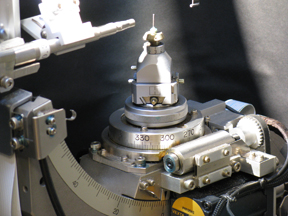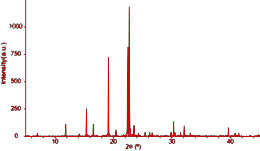| |
|
|
|
|
| |
|
|
|
|
|
|
POWDER X-RAY DIFFRACTION SERVICES
Rigaku R-Axis Spider:
The Rigaku R‐Axis Spider is equipped with an image plate area detector which enables the use of microgram sample sizes due to the higher sensitivity of detection when compared to a CCD detector. In addition, the X‐ray beam is collimated, allowing the beam to be adjusted to match a specific sample. Another feature of the R‐Axis spider is the use of a ¼ χ goniometer which can be oscillated in ω, χ, and φ to produce powder patterns with minimized preferred orientation and provides a more accurate identification of a crystalline phase. The R‐Axis Spider is equipped with an Oxford Instruments Cryostream Plus capable of temperatures in the range of 80 – 500 K and is ideal for solid‐state phase transitions and decomposition studies.
- Image plate area detector
- Cu Kα source
- Powder patterns can be obtained on μg sized samples
- Variable temperature capabilities (80 – 500 K)
- Oscillation of samples in ω, χ, and φ creates diffraction patterns with minimized preferred orientation
- Variable beam spot size (0.3, 0.5, and 0.8 mm)
To schedule use of this instrument, please contact Antek Wong-Foy at atkwong@umich.edu or 734-936-9867 |
|
 |
| |
|
|
Bruker D8 Advance Powder X-ray Diffractometer:
The Bruker D8 Advance is a conventional powder X-ray diffractometer that uses a 1.6 kW sealed tube X-ray source (Cu) and a vertical circle theta:theta goniometer with a measurement circle diameter of 500 mm for optimal angular resolution. In this design, the sample is held horizontally allowing the use of a number of different sample holders. This system features a 60 mm sealed Göbel mirror that creates a highly parallel incident beam and suppresses Kβ radiation. Parallel beam optics minimize peak position and shape errors due to sample displacement, flat specimen defocusing, sample transparency, and rough and/or irregular surface geometries. The detector is a LynxEye linear position sensitive detector that allows for ultra fast X-ray diffraction measurements. Compared to a single point detector, a 2theta range of 3.3° at 500 mm is simultaneously covered which is roughly equivalent to 200 point detectors simultaneously collecting data. 2theta range is from 3° to 145° maximum. Minimum step size achievable is <0.01° 2theta.
To schedule use of this equipment, please contact Antek Wong-Foy at atkwong@umich.edu or 734-936-9867 |
|
 |
|
| |
|
|
|




